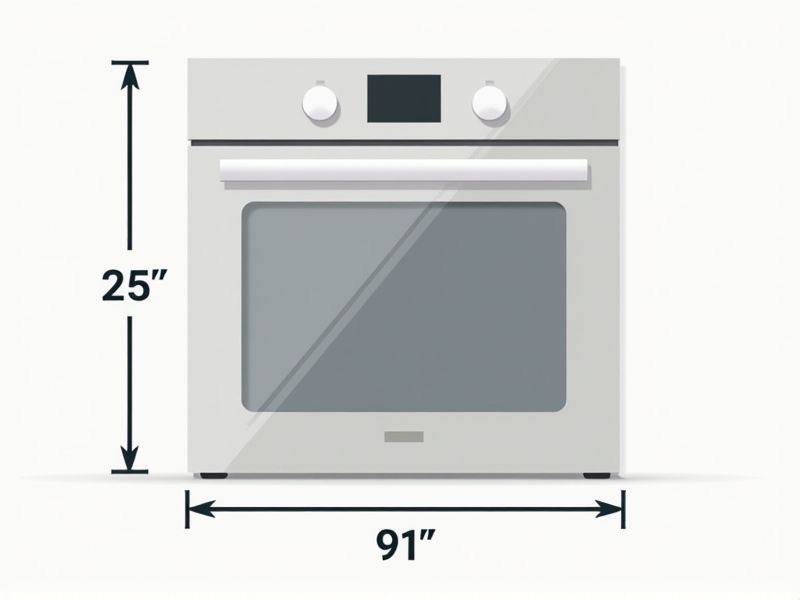
When planning for a wall oven, it's helpful to know that standard dimensions typically range from 24 to 30 inches in width, with 27 and 30 inches being the most common. The height of a single wall oven is usually around 27 to 29 inches, while double wall ovens are generally between 50 and 53 inches tall. Depth is commonly about 23 to 24 inches, ensuring the oven fits neatly within standard cabinetry. Always check the manufacturer's installation guide for precise measurements and allow for proper ventilation and door clearance in your kitchen layout.
Height
The standard height of a wall oven typically ranges from 27 to 30 inches, designed for ergonomic access and efficient use of kitchen space. Many modern designs offer adjustable heights to accommodate various user preferences and kitchen layouts. Wall ovens are often installed at eye level, ensuring that you can easily monitor cooking progress without bending over. Choosing the right height is essential for creating a functional and accessible kitchen environment.
Width
The standard width of a wall oven typically measures 30 inches, aligning with the dimensions of most kitchen cabinetry. Some models, however, may offer widths of 24 inches, 27 inches, or even 36 inches, catering to diverse kitchen layouts and design preferences. When selecting your wall oven, consider the available space to ensure optimal installation and functionality. Furthermore, ensure compatibility with your existing cabinetry to maintain an aesthetically pleasing and efficient kitchen environment.
Depth
The standard depth of wall ovens generally measures around 24 inches, ensuring they fit seamlessly into most kitchen cabinetry without compromising space. This depth accommodates the necessary ventilation and installation requirements, allowing for efficient heat circulation during cooking. Some models may extend to 30 inches to provide additional functionality, such as a larger internal capacity. When selecting a wall oven, consider your kitchen's layout and design to maximize both performance and aesthetic appeal.
Interior Capacity
A wall oven typically boasts an interior capacity ranging from 3.5 to 5.5 cubic feet, accommodating various cooking needs, from baking large casseroles to roasting multiple dishes simultaneously. The configuration often includes adjustable racks, allowing for custom placement to maximize space utilization. High-quality models may feature convection technology, which circulates hot air for even cooking and quicker baking times. When selecting a wall oven, consider your kitchen space and cooking frequency to ensure it meets your culinary demands.
Door Clearance
When considering the standard wall oven, door clearance is a crucial factor for installation and operation. Typically, a wall oven requires a clearance of at least 36 inches from the floor to the bottom of the oven door for optimal access and safety. This height ensures that you can easily open the door without obstruction, allowing for convenient loading and unloading of hot dishes. Maintaining proper door clearance also helps to avoid potential kitchen accidents, enhancing your cooking experience.
Cutout Dimensions
When selecting a wall oven, a critical factor is the cutout dimensions, which typically range from 28 to 30 inches in width, 24 inches in depth, and 27 to 29 inches in height. Precise measurements ensure proper installation and optimal performance, as even a slight deviation can affect airflow and heat distribution. You should also consider the cabinet configuration, which often requires a minimum clearance of 1 to 2 inches around the oven for ventilation. Standardized cutout requirements can significantly influence your kitchen layout and overall cooking experience.
Installation Type
Wall ovens are primarily categorized into three installation types: built-in, microwave-convection, and wall-mounted models. Built-in wall ovens are designed to seamlessly integrate into cabinetry, typically measuring 24 to 30 inches in width, providing a sleek, modern aesthetic. Microwave-convection wall ovens combine traditional baking with microwave functionality, often featuring cooking settings that can reduce cooking times by up to 30%. Wall-mounted models, generally more versatile, can be installed at different heights, allowing you to customize your kitchen layout to suit your ergonomic preferences.
Control Panel Placement
The control panel placement of a wall oven significantly influences user experience, with optimal positioning typically ranging between 36 to 48 inches above the floor. This height ensures that users can easily access settings without bending or stretching excessively. Models featuring a front-mounted control panel allow for a more streamlined design and convenient access, while side-mounted options can save space in compact kitchens. When choosing your wall oven, consider how the control panel's placement aligns with your cooking habits and overall kitchen layout for improved functionality.
Ventilation Requirements
A wall oven's ventilation requirements are crucial for maintaining optimal performance and safety. Typically, manufacturers recommend at least 200 cubic feet per minute (CFM) of ventilation to efficiently remove excess heat, smoke, and odors during cooking. Proper installation of a dedicated exhaust system is essential, often requiring a 6 to 10-inch duct to effectively channel air outside. Ensuring that your kitchen meets these ventilation standards not only enhances cooking comfort but also prolongs the lifespan of your wall oven.
Electrical Configuration
The standard wall oven typically operates at a voltage of 240 volts, which allows for efficient heating and cooking capabilities. Most models come with a power rating ranging from 2,500 to 5,000 watts, ensuring quick preheating times and consistent cooking temperatures. When considering your kitchen layout, you should also note that wall ovens often require a dedicated circuit to manage electrical load safely. Familiarizing yourself with the electrical requirements will enhance your cooking experience and ensure compliance with safety regulations.
